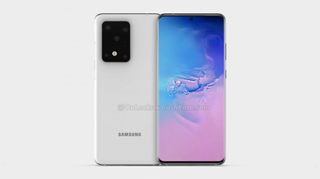Galaxy S11 may have a dedicated sensor for low-light photo and video
This is how Samsung will fight Apple and Google

If all these rumors turn out to be true, the Samsung Galaxy S11 is going to be full of camera tricks. Heck, with a rumored 108-megapixel main sensor, 100x zoom and now perhaps a dedicated low light photo and video sensor, this is starting to sound like a mythical unicorn phone for camera phone fans.
As Dutch tech blog and patent foragers LetsGoDigital reports, Samsung has filed a hardware trademark registration with the European Union Intellectual Property Office for something called the Bright Night Sensor — not to be confused with the Galaxy S10 and Galaxy Note 10’s “bright night” photography mode.
The trademark says that it covers “camera image sensors for smartphones, light sensors for smartphone cameras, image sensors for photographic devices, image sensors for video cameras.” The latter is new, as night mode has so far only been used for photography, not video.
Night mode usually works combining several images into a new image using artificial intelligence to blow up the overall illumination of a scene. Due to the computational cost of this type of processing, it is not possible to apply the same technique to video, which will require 30 or 60 frames to be processed per second.
A camera unicorn
Samsung may have solved this by turning one of the Galaxy S11’s alleged five — yeah, *five* — camera sensors into an specialized part designed to capture detail in the infrared spectrum. Combined with the normal 108-megapixel sensor, they may have achieved the right hardware solution to provide with good video capture in low-light shooting conditions.
On the other hand, this may also be a trademark to refer to the 108-megapixel sensor that is reportedly going in the Galaxy S11 line. Two factors play in favor of this being the case. First is the part name: Isocell Bright HMX (although Samsung has other sensors with “Bright” on their names, like the 64-megapixel Isocell Bright GW1).
The second one is that this Samsung sensor will be exceptionally sensitive to light. It will have a much larger area than competitive chips by Sony while maintaining a 0.8-micrometer pixel size. The sensor has a total area of 1/1.33-inch, much larger than the 1/1.7-inch sensor in Huawei P30 Pro an almost as large as a regular compact camera. That will give it a higher light sensitivity than normal just by itself, but this is also a Quad-Bayer photo sensor. That means that is capable of grouping pixels in groups of four, reducing its total resolution to 27 megapixels but dramatically increasing its photosensitivity for both photography and videography applications.
Sign up to get the BEST of Tom’s Guide direct to your inbox.
Upgrade your life with a daily dose of the biggest tech news, lifestyle hacks and our curated analysis. Be the first to know about cutting-edge gadgets and the hottest deals.
So perhaps this Bright Night Sensor will be the consumer name for the Isocell Bright HMX. Or maybe Samsung does indeed have a dedicated night photography sensor to turn night into day. At this point, with magical 100x zooms and all the other rumored tech, nobody knows anything anymore.
The Samsung Galaxy S11 line — which will feature 12GB or memory, up to a terabyte of storage, and the latest Exynos or Snapdragon processor depending on your region — will appear sometime around February 2020. We will see if this unicorn phone will run on actual batteries or pixie dust.
Jesus Diaz founded the new Sploid for Gawker Media after seven years working at Gizmodo, where he helmed the lost-in-a-bar iPhone 4 story and wrote old angry man rants, among other things. He's a creative director, screenwriter, and producer at The Magic Sauce, and currently writes for Fast Company and Tom's Guide.

